Charles VIII of France
| Charles VIII the Affable | |
|---|---|
| King of France, Duke of Brittany, Count of Provence | |
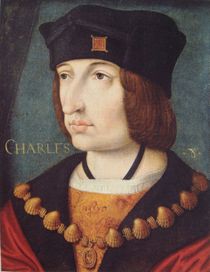 |
|
| Charles VIII, Ecole Française, 16th century. Musée Condé, Chantilly. | |
|
|
|
| Reign | 30 August 1483 – 7 April 1498 |
| Coronation | 30 May 1484, Reims |
| Predecessor | Louis XI |
| Successor | Louis XII |
| Spouse | Anne, Duchess of Brittany |
| House | House of Valois |
| Father | Louis XI of France |
| Mother | Charlotte of Savoy |
| Born | 30 June 1470 Château d'Amboise, France |
| Died | 7 April 1498 (aged 27) Château d'Amboise, France |
Charles VIII, called the Affable, French: l'Affable (30 June 1470 – 7 April 1498), was King of France from 1483 to his death in 1498. Charles was a member of the House of Valois. His invasion of Italy initiated the long series of Franco-Italian wars which characterized the first half of the 16th century.
Contents |
Childhood and youth
Charles was born at the Château d'Amboise in France, the only surviving son of King Louis XI by his second wife Charlotte of Savoy. His godfather was Edward of Westminster the son of King Henry VI of England who had been living in France since the deposition of his father by King Edward IV. Charles succeeded to the throne on 30 August 1483, at age 13. His health was poor and he was regarded by his contemporaries as of pleasant disposition but foolish and unsuited for the business of the state. In accordance with Louis XI's wishes, the regency of the Kingdom was granted to Charles' elder sister, Anne, a formidably intelligent and shrewd woman described by her father as "the least insane woman in France." She would rule as regent, together with her husband Peter II, Duke of Bourbon, until 1491.
Marriages
Charles was betrothed in 1482 to Margaret of Austria, the daughter of Emperor Maximilian I and Mary, Duchess of Burgundy; the marriage had been arranged by Louis XI, Maximilian, and the Estates of the Low Countries, as part of the Peace of Arras between France and Burgundy. Margaret brought the Counties of Artois and Burgundy to France as her dowry, and she was raised in the French court as prospective Queen consort.
In 1488, however, Francis II, Duke of Brittany died in a riding accident, leaving his 11-year old daughter Anne as his heiress. Anne, who feared for her Duchy's independence against the ambitions of France, arranged a marriage in 1490 between herself and Maximilian, who had already married Mary of Burgundy in much the same circumstances in 1477-thus making Anne a stepmother to Margaret of Austria. The Beaujeus refused to countenance such a marriage, however, since it would place Maximilian and his family, the Habsburgs, on two French borders; Brittany was invaded by the French army, Maximilian was unable to help, and Anne of Brittany was forced to renounce Maximilian (whom she had only married by proxy), and agree to be married to Charles VIII instead.
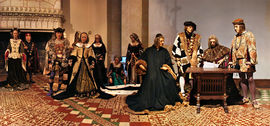
at the Château de Langeais.
In December 1491, in an elaborate ceremony at the Château de Langeais, Charles and Anne of Brittany were married. The 14-year-old Duchess Anne, not happy with the arranged marriage, arrived for her wedding with her entourage carrying two beds. However, Charles's marriage brought him independence from his relatives, and thereafter he managed affairs according to his own inclinations. Queen Anne lived at the Clos Lucé in Amboise.
There still remained the matter of Charles' first intended, the young Margaret of Austria. Although the cancellation of her betrothal meant that she by rights should have been returned to her family, Charles did not initially do so, intending to marry her usefully elsewhere in France. It was an abominable situation for Margaret, who informed her father in her letters that she was so determined to escape her situation that she would even flee Paris in her nightgown if it gave her freedom. Eventually, in 1493, she was returned to her family, together with her dowry.
The Italian War
|
||||||||||||||||||||||||||||||
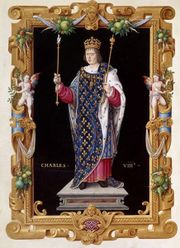
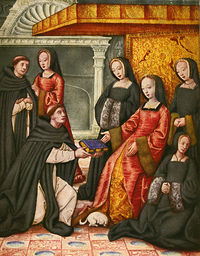
To secure France against invasions, Charles made treaties with Austria and England, buying their neutrality with big concessions. He devoted France's resources to building up a large army, including one of Europe's first siege trains with artillery.
In 1489, Pope Innocent VIII, then being at odds with Ferdinand I of Naples, offered Naples to Charles, who had a vague claim to the Kingdom of Naples through his paternal grandmother, Marie of Anjou. In 1494, Ludovico Sforza, Duke of Milan, was threatened by Ferdinand's successor Alfonso II, and urged Charles to go take Naples. Charles was also urged on by his favorite courtier, Étienne de Vesc. Thus encouraged, Charles imagined himself capable of actually taking Naples.
Charles entered Italy with 25,000 men (including 8,000 Swiss mercenaries) in 1494 and marched across the peninsula, reaching Naples on 22 February 1495.[1] The French army subdued Florence in passing and took Naples without a pitched battle or siege. Alfonso was expelled and Charles was crowned King of Naples.
There were those in the Republic of Florence who appreciated the presence of the King and his Army. The famous friar Savonarola believed that King Charles VIII was God's tool to purify the corruption of Florence. Once the King had ousted the evil sinners of Florence the city would become center of morality and thus the appropriate place to restructure the Church. This situation would eventually spill over into another conflict between Pope Alexander VI, who despised the King in Italy, and Savonarola, who called for the King's intervention. This conflict would eventually lead Savonarola to be suspected of heresy and executed by the State.
The speed and power of the French advance frightened the other Italian rulers, including the Pope and even Ludovico of Milan. They formed an anti-French coalition, the League of Venice. At Fornovo in July 1495, the League defeated Charles, despite losing 2,000 men to his 1,000. Charles lost nearly all the booty of the campaign and had to withdraw to France. His remaining garrisons in Naples were quickly subdued by Aragonese allies of Alfonso.
Over the next few years, Charles tried to rebuild his army, and resume the campaign. But he was hampered by the large debts incurred in 1494-95. He never succeeded in gaining anything substantive.
Death
Charles died in 1498, two and a half years after his retreat from Italy, as the result of an accident. While playing jeu de paume (real tennis) in Amboise he struck his head on the lintel of a door.[2] A few hours later, he fell into a sudden coma, and then died.
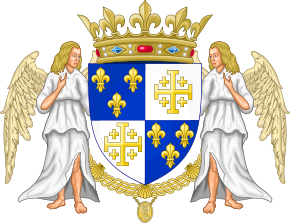
Legacy
Charles bequeathed a meager legacy: he left France in debt and in disarray as a result of an ambition most charitably characterized as unrealistic. On a more positive side, his expedition did strengthen cultural ties to Italy, energizing French art and letters in the latter part of the Renaissance.
Since all of his children died before him, Charles was the last of the elder branch of the House of Valois. Upon his death, the throne passed to his father's second cousin, the Duke of Orléans, who reigned as King Louis XII of France.
Ancestry
|
|
|
|
|
|
|
|
|
|
|
|
|
|
|
|
|
|
|
|
16. Charles V of France | |||||||||||||||
|
|
||||||||||||||||
|
|
|
|
|
|
||||||||||||
|
|
8. Charles VI of France |
|
||||||||||||||
|
|
||||||||||||||||
|
|
|
|
|
|
|
|
|
|||||||||
|
|
17. Joanna of Bourbon | |||||||||||||||
|
|
||||||||||||||||
|
|
|
|
|
|
||||||||||||
|
|
4. Charles VII of France |
|
||||||||||||||
|
|
||||||||||||||||
|
|
|
|
|
|
|
|
|
|
|
|
||||||
|
|
18. Stephen III, Duke of Bavaria | |||||||||||||||
|
|
||||||||||||||||
|
|
|
|
|
|
||||||||||||
|
|
9. Isabeau of Bavaria |
|
||||||||||||||
|
|
||||||||||||||||
|
|
|
|
|
|
|
|
|
|||||||||
|
|
19. Taddea Visconti | |||||||||||||||
|
|
||||||||||||||||
|
|
|
|
|
|
||||||||||||
|
|
2. Louis XI of France |
|
||||||||||||||
|
|
||||||||||||||||
|
|
|
|
|
|
|
|
|
|
|
|
|
|
|
|||
|
|
20. Louis I of Naples | |||||||||||||||
|
|
||||||||||||||||
|
|
|
|
|
|
||||||||||||
|
|
10. Louis II of Naples |
|
||||||||||||||
|
|
||||||||||||||||
|
|
|
|
|
|
|
|
|
|||||||||
|
|
21. Marie of Blois | |||||||||||||||
|
|
||||||||||||||||
|
|
|
|
|
|
||||||||||||
|
|
5. Marie of Anjou |
|
||||||||||||||
|
|
||||||||||||||||
|
|
|
|
|
|
|
|
|
|
|
|
||||||
|
|
22. John I of Aragon | |||||||||||||||
|
|
||||||||||||||||
|
|
|
|
|
|
||||||||||||
|
|
11. Yolande of Aragon |
|
||||||||||||||
|
|
||||||||||||||||
|
|
|
|
|
|
|
|
|
|||||||||
|
|
23. Violante de Bar | |||||||||||||||
|
|
||||||||||||||||
|
|
|
|
|
|
||||||||||||
|
|
1. Charles VIII of France |
|
||||||||||||||
|
|
||||||||||||||||
|
|
|
|
|
|
|
|
|
|
|
|
|
|
|
|
|
|
|
|
24. Amadeus VII, Count of Savoy | |||||||||||||||
|
|
||||||||||||||||
|
|
|
|
|
|
||||||||||||
|
|
12. Antipope Felix V |
|
||||||||||||||
|
|
||||||||||||||||
|
|
|
|
|
|
|
|
|
|||||||||
|
|
25. Bonne of Berry | |||||||||||||||
|
|
||||||||||||||||
|
|
|
|
|
|
||||||||||||
|
|
6. Louis, Duke of Savoy |
|
||||||||||||||
|
|
||||||||||||||||
|
|
|
|
|
|
|
|
|
|
|
|
||||||
|
|
26. Philip the Bold | |||||||||||||||
|
|
||||||||||||||||
|
|
|
|
|
|
||||||||||||
|
|
13. Mary of Burgundy |
|
||||||||||||||
|
|
||||||||||||||||
|
|
|
|
|
|
|
|
|
|||||||||
|
|
27. Margaret III, Countess of Flanders | |||||||||||||||
|
|
||||||||||||||||
|
|
|
|
|
|
||||||||||||
|
|
3. Charlotte of Savoy |
|
||||||||||||||
|
|
||||||||||||||||
|
|
|
|
|
|
|
|
|
|
|
|
|
|
|
|||
|
|
28. James I of Cyprus | |||||||||||||||
|
|
||||||||||||||||
|
|
|
|
|
|
||||||||||||
|
|
14. Janus of Cyprus |
|
||||||||||||||
|
|
||||||||||||||||
|
|
|
|
|
|
|
|
|
|||||||||
|
|
29. Helisia of Brunswick-Grubenhagen | |||||||||||||||
|
|
||||||||||||||||
|
|
|
|
|
|
||||||||||||
|
|
7. Anne of Cyprus |
|
||||||||||||||
|
|
||||||||||||||||
|
|
|
|
|
|
|
|
|
|
|
|
||||||
|
|
30. John I, Count of La Marche | |||||||||||||||
|
|
||||||||||||||||
|
|
|
|
|
|
||||||||||||
|
|
15. Charlotte de Bourbon-La Marche |
|
||||||||||||||
|
|
||||||||||||||||
|
|
|
|
|
|
|
|
|
|||||||||
|
|
31. Catherine of Vendôme | |||||||||||||||
|
|
||||||||||||||||
|
|
|
|
|
|
||||||||||||
Issue
The marriage with Anne resulted in the birth of four children:
- Charles-Orland, Dauphin of France (11 October 1492 – 16 December 1495).
- Charles, Dauphin of France (8 September–2 October 1496).
- François, Dauphin of France (July 1497).
- Princess Anne of France (1498).
See also
- First Italian War
References
|
Charles VIII of France
House of Valois
Cadet branch of the Capetian dynasty
Born: 30 June 1470 Died: 7 April 1498 |
||
| Regnal titles | ||
|---|---|---|
| Preceded by Louis XI |
King of France 30 August 1483 – 7 April 1498 |
Succeeded by Louis XII |
| Preceded by Alphonse II |
King of Naples February 1495 – July 1495 |
Succeeded by Ferdinand II |
| French royalty | ||
| Preceded by Vacant (Francis, 10th Dauphin) |
Dauphin of France as 'Charles, 11th Dauphin' 30 June 1470 – 30 August 1483 |
Succeeded by Vacant (eventually Charles Orlando, 12th Dauphin) |
| Preceded by Charles de Valois, Duc de Berry |
Heir to the Throne as Heir apparent 30 June 1470 – 30 August 1483 |
Succeeded by Louis, Duke of Orléans |
| French nobility | ||
| Preceded by Anne |
Duke of Brittany de jure uxoris with Anne of Brittany 6 December 1491 – 7 April 1498 |
Succeeded by Louis XII of France |
| Preceded by Vacant (Charles III) |
Count of Provence and Forcalquier as 'Charles IV' 1486 – 7 April 1498 |
|
| Preceded by Louis II |
Dauphin of Viennois, Count of Valentinois and of Diois as 'Charles VI of Viennois' 30 June 1470 – 11 October 1492 16 December 1495 – 8 September 1496 2 October 1496 – July 1497 July 1497 – 7 April 1498 |
Succeeded by Charles VII |
| Preceded by Charles VII |
Succeeded by Charles VIII |
|
| Preceded by Charles VIII |
Succeeded by Francis II |
|
| Preceded by Francis II |
Succeeded by Louis III |
|
|
|||||||||||||||||||||||||||||||||||||||||
.svg.png)